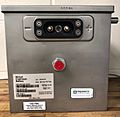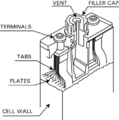Nickel cadmium battery facts for kids
A nickel-cadmium battery, often called NiCd or Nicad, is a type of rechargeable battery. This means you can use it, drain its power, and then charge it up again to use many times! For a long time, NiCd batteries were very popular in things like cordless phones, flashlights, and even some power tools.
Contents
How NiCd Batteries Work
A battery creates electricity through a chemical reaction. In a NiCd battery, this reaction happens between two main chemicals: cadmium metal and nickel(III) oxide.
- When the battery is used (discharging), the cadmium metal gives up electrons in a process called oxidation.
- At the same time, the nickel(III) oxide takes in electrons.
- An important liquid called an electrolyte helps move the charged particles (ions) between the cadmium and nickel parts. For NiCd batteries, this electrolyte is usually Potassium hydroxide.
This movement of electrons creates the electric current that powers your devices. When you charge the battery, the chemical reactions reverse, storing energy for later use.
Why NiCd Batteries Are Less Common Now
While NiCd batteries were very useful, they have a big drawback: they contain cadmium. Cadmium is a toxic metal, which means it can be harmful to people and the environment if not handled properly. Because of this, newer and safer types of rechargeable batteries have become more popular. The nickel-metal hydride (NiMH) battery is one example that has largely replaced NiCd batteries in many devices. When NiCd batteries are no longer useful, it's important to recycle them correctly so the cadmium doesn't harm the environment.
Related pages
Images for kids
See also
 In Spanish: Batería de níquel-cadmio para niños
In Spanish: Batería de níquel-cadmio para niños





